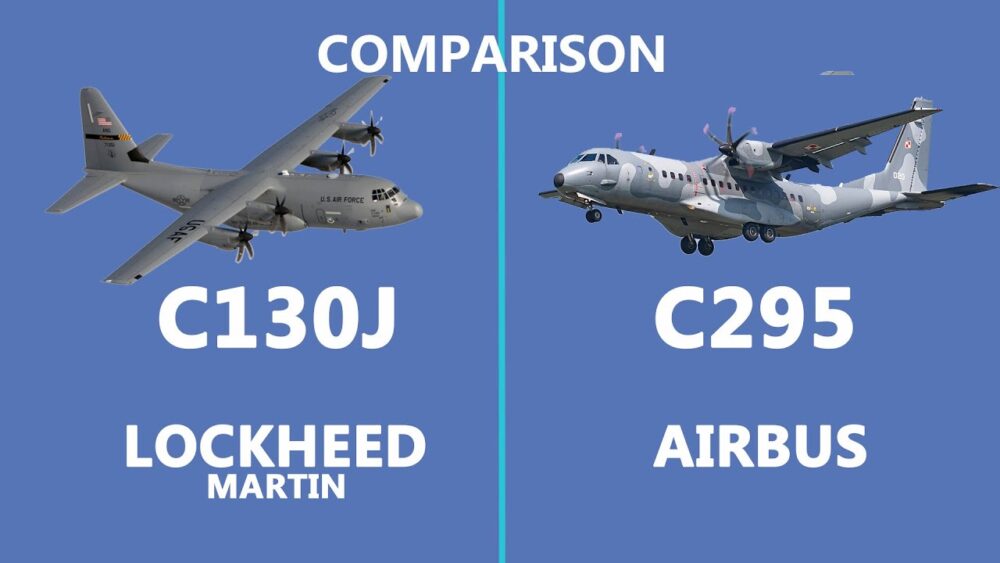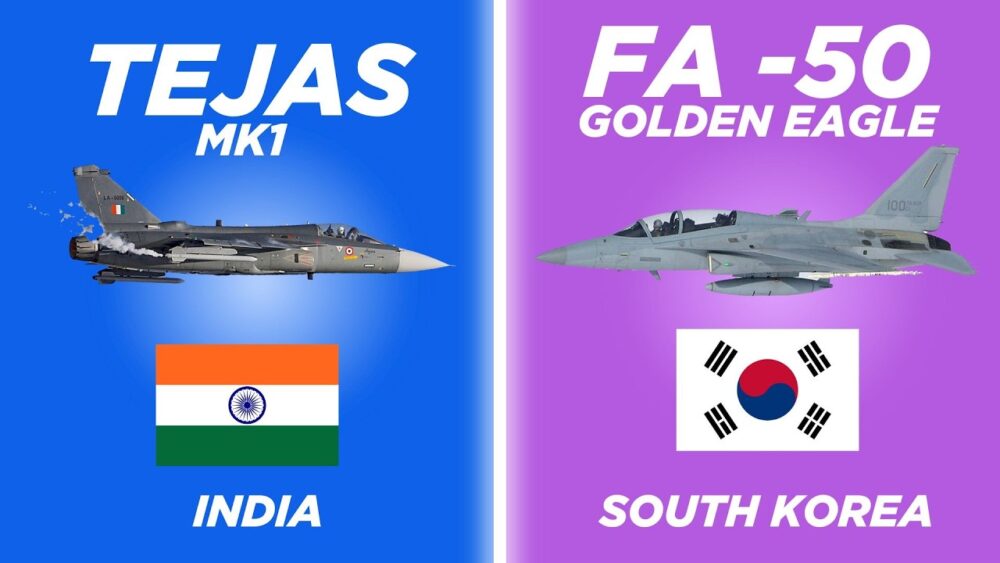Aircraft comparison
Comparison of the C130J vs C295 cargo aircraft

The Airbus C295 and Lockheed Martin C-130J are two of the most versatile military transport aircraft, each known for its unique strengths across various missions.
While both aircraft are highly capable in transporting troops, cargo, and performing specialized missions, they cater to different operational needs based on their size, capacity, range, and adaptability.
In this comparison, we will delve into the specifications, performance, and operational advantages of the C295 and C-130J, providing insights to help evaluate their suitability for modern military and logistical challenges.
Air India Might Operate Tata-Made New Airbus C295 Aircraft
The Airbus C295 is designed with a focus on short take-off and landing (STOL) capabilities, making it highly effective for regional and remote area transport. This STOL ability allows it to operate from shorter, less-prepared runways, ideal for accessing challenging locations.
In contrast, the Lockheed Martin C-130J prioritizes a larger payload capacity and greater range, enabling it to carry more cargo over longer distances, which is essential for strategic operations. This extended range and load capability make the C-130J well-suited for larger, more demanding missions requiring heavy transport and extended reach.
Here is the Specification of both aircraft.
Length: The Airbus C-295 measures 24.46 meters (80 feet 3 inches) in length, while the Lockheed Martin C-130J is significantly longer at 29.79 meters (97 feet 9 inches).
Max Takeoff Weight: The C-295 has a maximum takeoff weight of 21,000 kg (46,297 lb) for normal operations and 23,200 kg (51,147 lb) for overload. In contrast, the C-130J has a significantly higher maximum takeoff weight of 70,307 kg (155,000 lb).
Fuel Capacity: The C-295 has a fuel capacity of 7,650 liters (2,020 US gallons) and offers an optional in-flight refueling probe. The C-130J, while specific capacity details are not listed, can carry larger amounts of fuel to support its extended range.
Powerplant: The C-295 is powered by two Pratt & Whitney Canada PW127G turboprop engines, providing 1,972 kW (2,644 hp) each, while the C-130J features four Rolls-Royce AE 2100D3 turboprop engines, delivering 3,458 kW (4,637 shp) each.
Range: The C-295 has a normal payload range of 1,555 km (966 miles), whereas the C-130J boasts a maximum range of 3,300 km (2,100 miles) with a normal payload of 15,422 kg (34,000 lb).
Hardpoints: The C-295 features six hardpoints for carrying additional payloads, with a maximum capacity of 800 kg (1,764 lb) on inboard pylons. The C-130J is equipped with six wing hardpoints that allow it to carry extra fuel tanks, sensors, and a variety of weapons, making it more versatile for both cargo and combat roles.
Propellers: The C-295 uses six-bladed Hamilton Sundstrand HS-568F-5 composite propellers, while the C-130J is equipped with six-bladed Dowty R391 composite constant-speed propellers that feature fully feathering and reversible pitch capabilities.
The C295 is equipped with advanced avionics and navigation systems, including a digital cockpit with modern displays and controls, and an integrated mission system for surveillance and communication tasks.
The C-130J Hercules is equipped with advanced avionics and navigation systems as well. It features a modern glass cockpit with digital displays and controls, enhancing situational awareness for the crew. The aircraft includes an integrated mission system that supports various tasks, such as aerial refueling, cargo management, and tactical operations. Additionally, its advanced communication systems ensure reliable connectivity during missions, making it effective for both military and humanitarian operations.
Airbus Final Assembly Line Adapts for A350 Freighter Production
Recently, Airbus inaugurated a Final Assembly Line (FAL) for the C295 aircraft in Vadodara, Gujarat, as part of the ‘Make in India’ initiative. This project aims to deliver 56 C295 aircraft to the Indian Air Force (IAF), with 40 units being manufactured locally and 16 delivered from Spain. So far, six aircraft have already been delivered.
Meanwhile, Lockheed Martin has partnered with Tata Advanced Systems to strengthen support for India’s C-130J Super Hercules fleet. This collaboration aims to set up a Maintenance, Repair, and Overhaul (MRO) hub in India and increase local production of C-130J units, pending approval from the US and Indian governments.
The C-295 has been acquired by several countries, including India, Spain, Egypt, Poland, Canada, Brazil, Mexico, and Portugal, with a total of 225 units built. In comparison, as of March 2022, 500 C-130J aircraft have been delivered to 26 operators across 22 countries.

Aircraft comparison
Comparison of the Indian built Tejas MK1A vs South korean FA 50

Today, we’ll explore two remarkable light combat aircraft: the Tejas MK1A and the FA-50 Golden Eagle. Both fighters are designed for versatility, making them ideal for various missions, from air-to-air combat to ground support.
The Tejas MK1A, developed by Hindustan Aeronautics Limited (HAL) in India, and the FA-50, a product of Korea Aerospace Industries (KAI), are both advanced aircraft equipped with modern technology and features.
10 Fascinating Facts About India’s AMCA Fighter Jet
In this Article, we will compare these two fighters in terms of their specifications, performance, capabilities, and roles in modern air forces. Let’s dive in and see how they stack up against each other!
Tejas is the second supersonic combat aircraft developed by Hindustan Aeronautics Limited (HAL), following the HF-24 Marut. It took its first flight in 2001 and was inducted into service with the Indian Air Force (IAF) in 2015. Currently, Tejas holds the distinction of being the smallest and lightest aircraft in its class of supersonic combat jets.
On the other hand, the FA-50 is South Korea’s first indigenous supersonic aircraft and is one of the few supersonic trainers in the world. Development of the T-50 began in the late 1990s, with its maiden flight taking place in 2002.
Russia Seeks Talks with India, Offers Tu-160 Bombers at Unbeatable Prices
The FA-50 boasts a higher production rate compared to the Tejas. Over the past 15 years, Korea Aerospace Industries (KAI) has produced nearly 200 variants of the FA-50, while Tejas has seen a lower production output.
In terms of international sales, the FA-50 is actively in service with multiple countries, including Indonesia, Iraq, the Philippines, Thailand, and Poland. Notably, Malaysia opted for the FA-50 over the Tejas, citing the FA-50’s strong service record as a key factor in their decision.
Here’s a SPECIFICATION of the Tejas and FA-50
Length: The Tejas measures 13.2 m (43 ft 4 in), making it slightly longer than the FA-50, which is 13.14 m (43 ft 1 in).
Max Takeoff Weight: The Tejas has a maximum takeoff weight of 13,500 kg (29,762 lb), compared to the FA-50’s lighter weight of 10,722 kg (23,638 lb).
Fuel Capacity: The Tejas has an internal fuel capacity of 3,060 liters (810 US gallons), while the FA-50 has a slightly lower internal fuel capacity of 2,655 liters (701 US gallons).
Powerplant: Both aircraft are powered by General Electric F404 turbofan engines, but the Tejas utilizes the F404-GE-IN20 variant with 48.9 kN (11,000 lbf) thrust dry and 85 kN (19,000 lbf) with afterburner. The FA-50 features the F404-GE-102 variant, producing 53.07 kN (11,930 lbf) thrust dry and 78.7 kN (17,700 lbf) with afterburner.
Maximum Speed: The Tejas has a maximum speed of 2,220 km/h (Mach 1.8), which is significantly faster than the FA-50’s maximum speed of 1,837.5 km/h (Mach 1.5).
Combat Range: The Tejas has a combat range of 739 km (459 mi), whereas the FA-50 has a much longer range of 1,851 km (1,150 mi).
Hardpoints: The Tejas features 9 hardpoints with a total capacity of 5,300 kg, while the FA-50 has 7 hardpoints capable of carrying up to 5,400 kg of payload.
Cost: The Tejas is priced at approximately $40 million per unit, whereas the FA-50 ranges between $30 million to $40 million per unit, making the FA-50 potentially more cost-effective depending on the variant chosen.
Weapons
When it comes to weaponry, the Tejas MK1A offers a wider range of options compared to the FA-50 Golden Eagle. The Tejas MK1A is equipped with beyond-visual-range (BVR) missiles, allowing it to engage targets at greater distances, enhancing its combat effectiveness in air superiority missions. Additionally, it can carry precision-guided munitions for accurate strikes against ground targets, as well as standoff weapons, which can be launched from a distance to minimize exposure to enemy defenses. This diverse armament enables the Tejas to perform a variety of roles, from air-to-air combat to ground support.
In contrast, the FA-50 also features a respectable armament capability but has a more limited selection. It can carry air-to-air missiles like the AIM-9 Sidewinder and AIM-120 AMRAAM, as well as precision-guided bombs. However, its focus leans more toward close air support and light strike missions rather than the extensive versatility that the Tejas offers.
Naval Variant
The Tejas Mk1A has a naval variant designed for carrier operations, which is still in development. This version includes upgrades like a nose droop for better visibility during landings and takeoffs, a strengthened undercarriage, and an arrestor hook for safe landings on aircraft carriers.
In contrast, the FA-50 does not have a naval variant. While it’s versatile for different missions, it’s not designed for carrier operations, limiting its flexibility compared to the naval Tejas, which can operate from both land and carriers.
-

 Aviation2 months ago
Aviation2 months agoMicrosoft Flight Simulator Raises $3 Million to Bring Back the An-225 Mriya
-

 Airlines2 months ago
Airlines2 months agoQatar Citizens Can Travel to the United States Without a Visa
-

 Aviation2 months ago
Aviation2 months agoQatar Airways bans these new Electronic Devices on plane
-

 Defence2 months ago
Defence2 months agoWhich Country Has the Largest Fleet of Fighter Aircraft?
-

 Airlines5 days ago
Airlines5 days agoDAMAC Air: Dubai’s New Luxury Airline Offers Free Flights for Registration
-

 Airport2 months ago
Airport2 months agoWestern Sydney Airport Welcomes Its First Plane After 6 Years of construction
-

 Airlines4 days ago
Airlines4 days agoAir India to Launch aircraft maintenance training institute in Bengaluru
-

 Aviation2 months ago
Aviation2 months agoDid you know ? Once Boeing 747 carried 1088 passenger in 1991









You must be logged in to post a comment Login